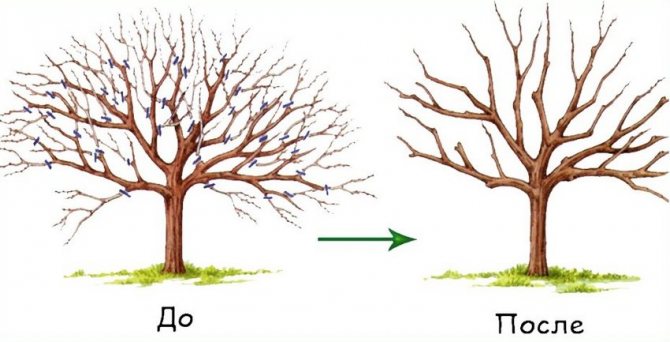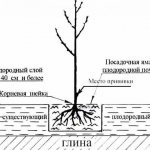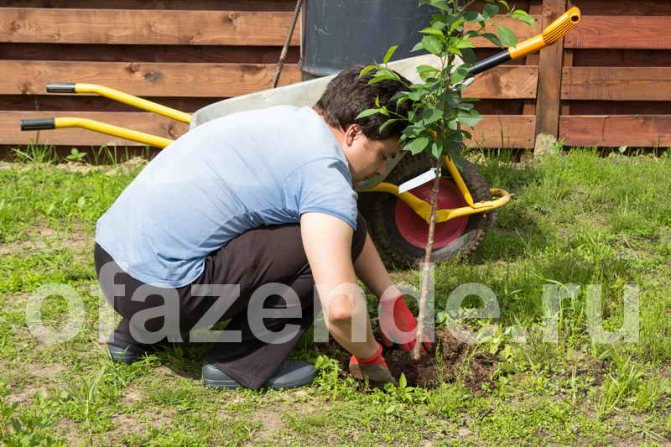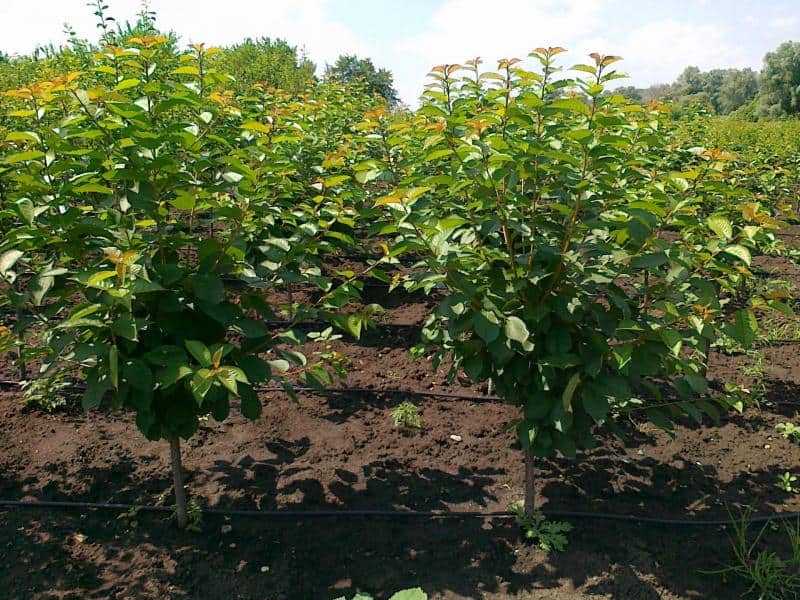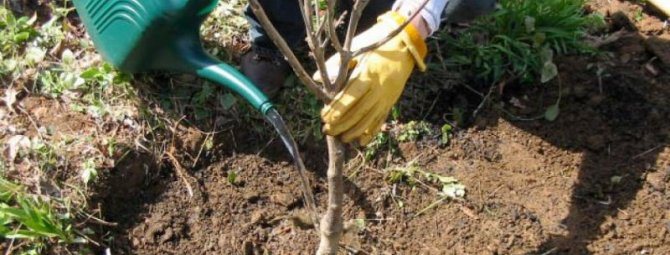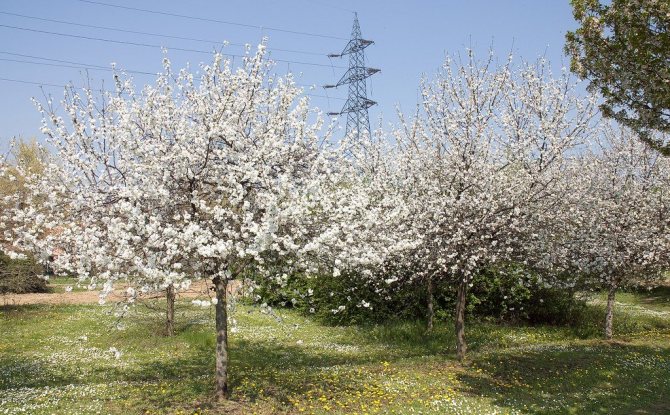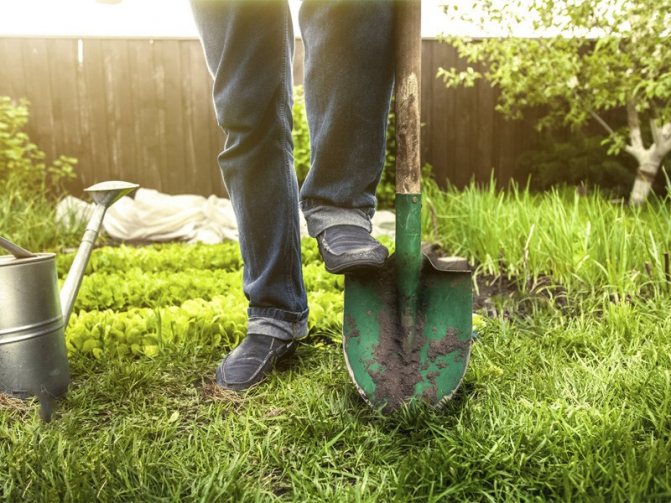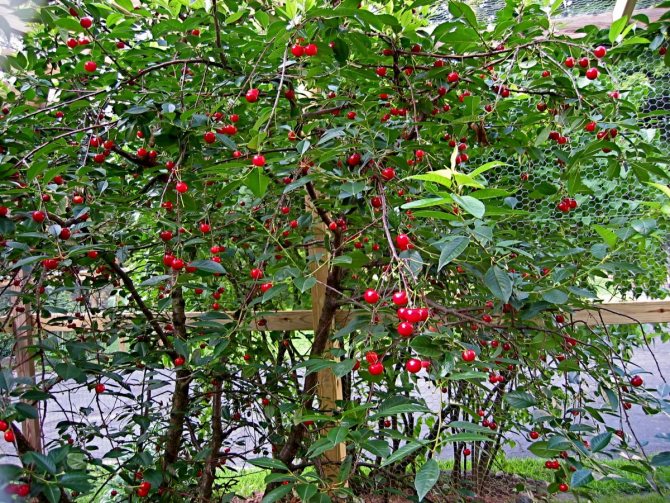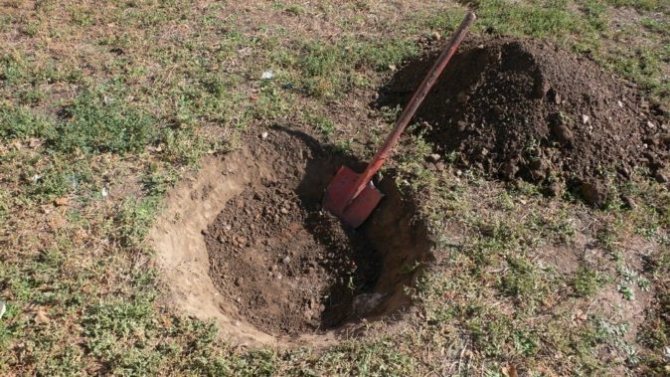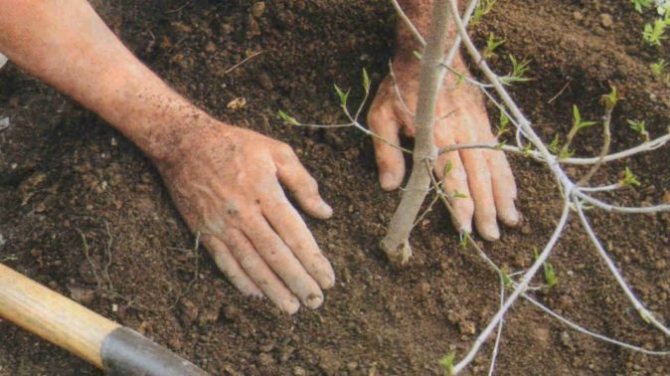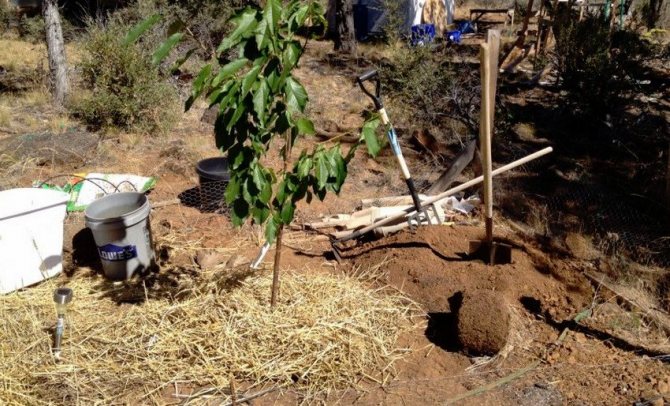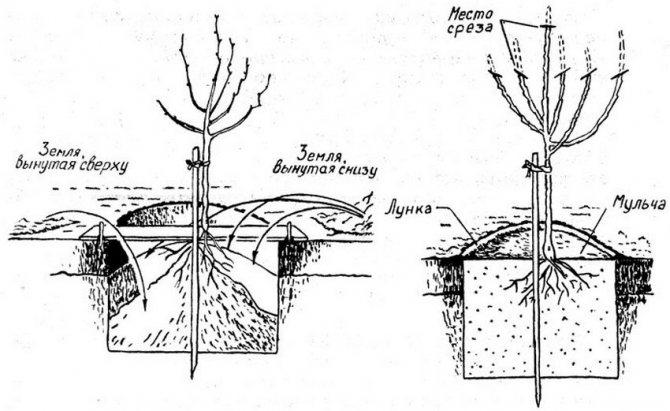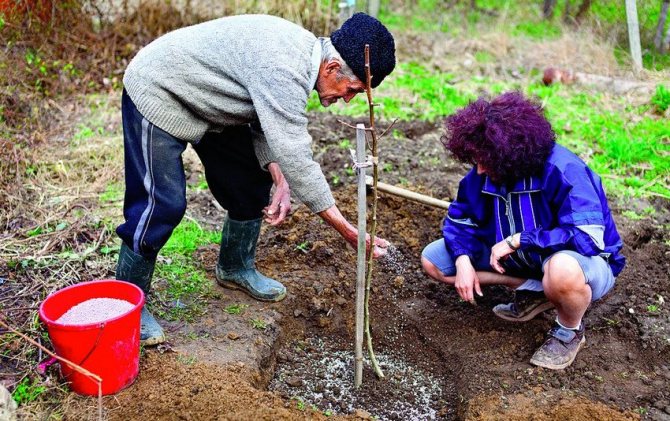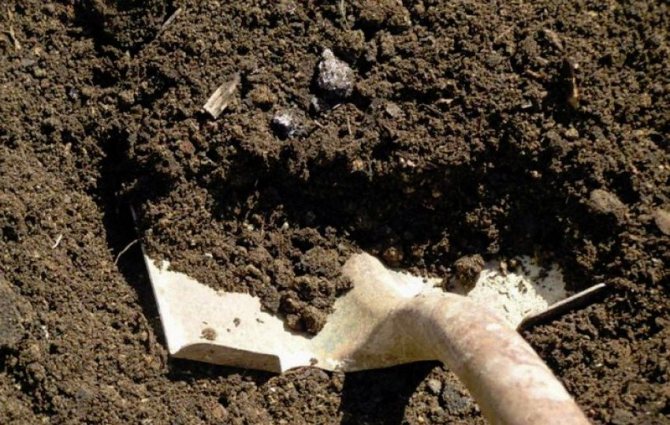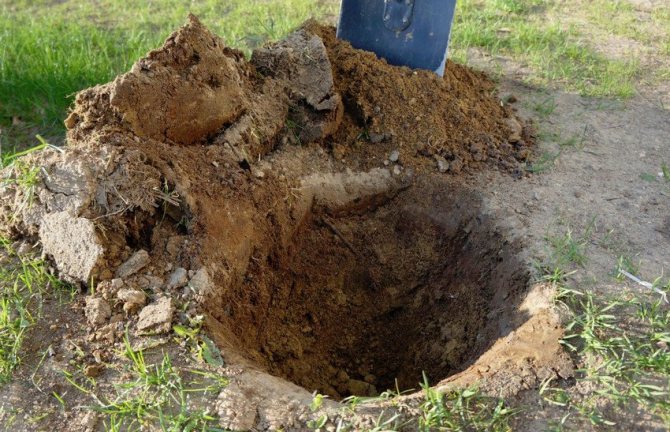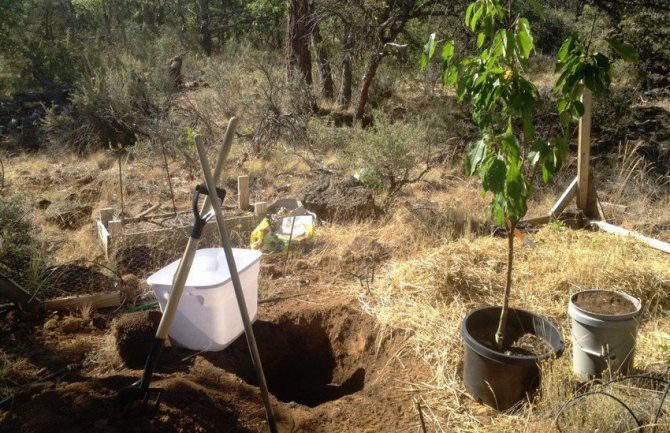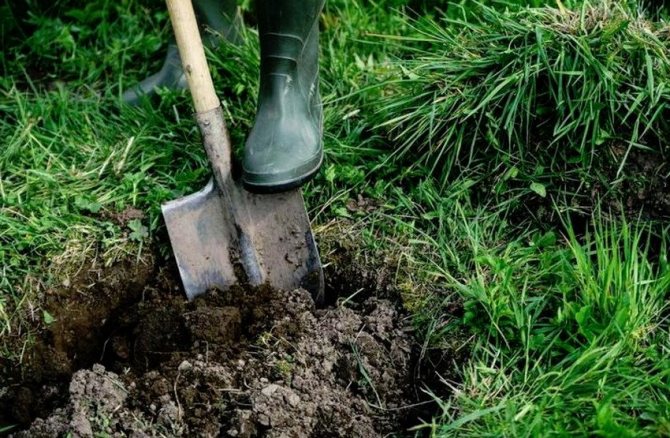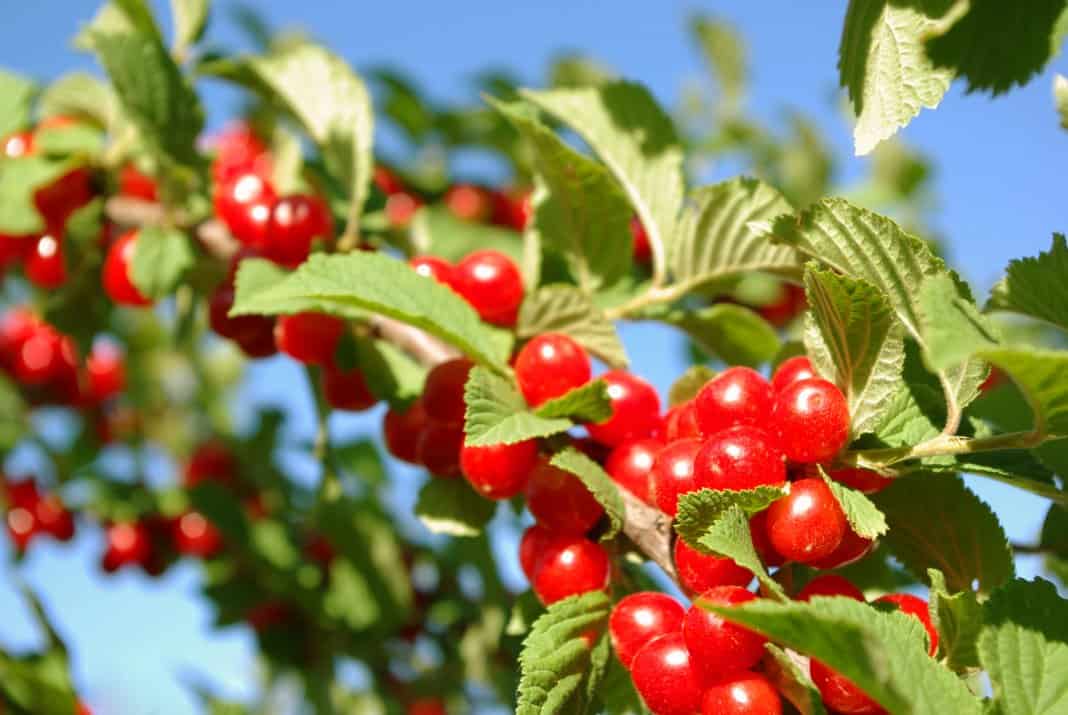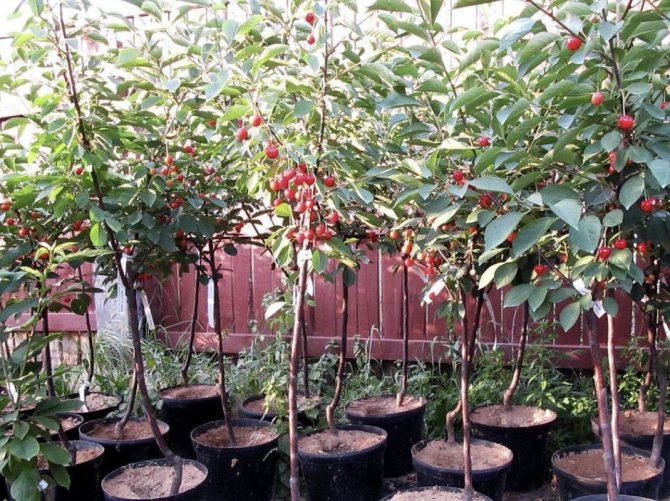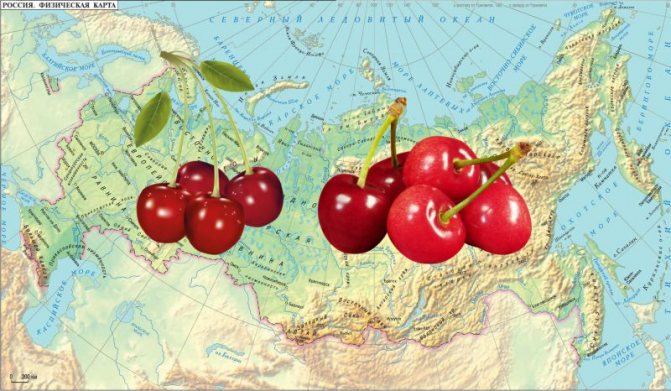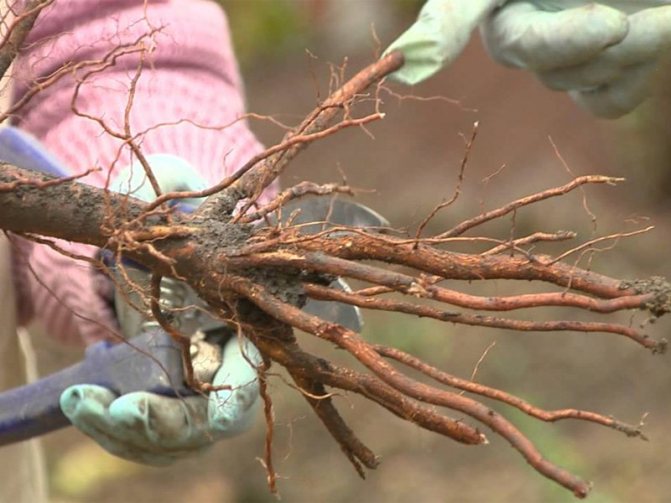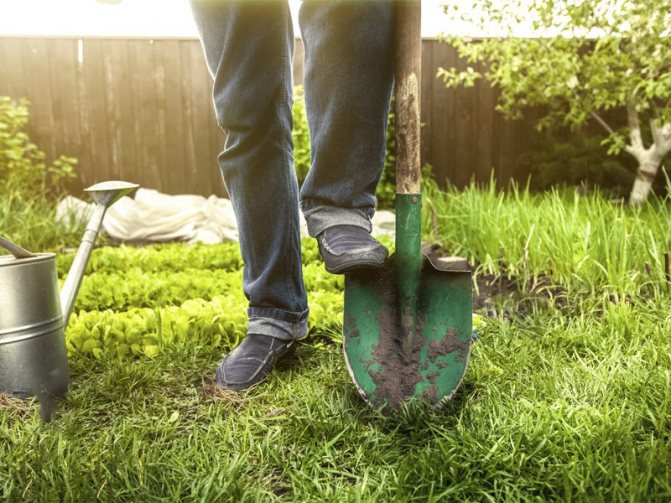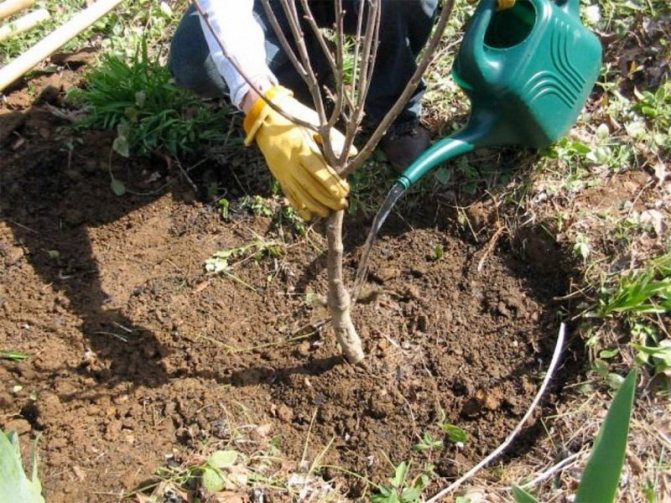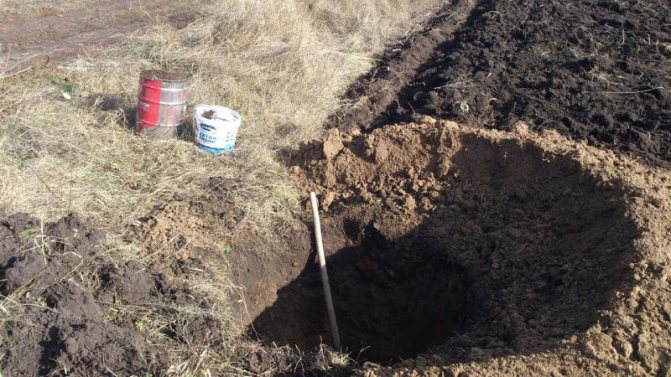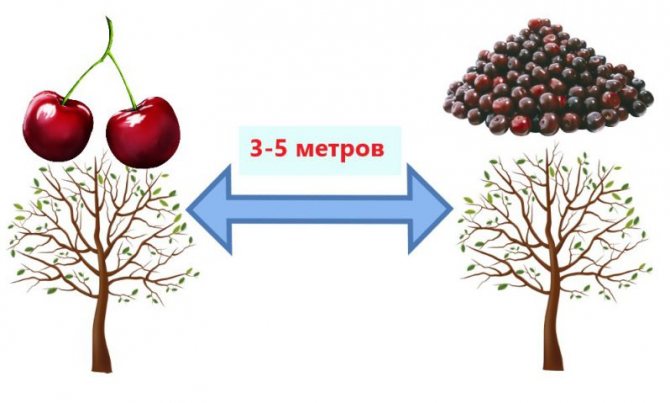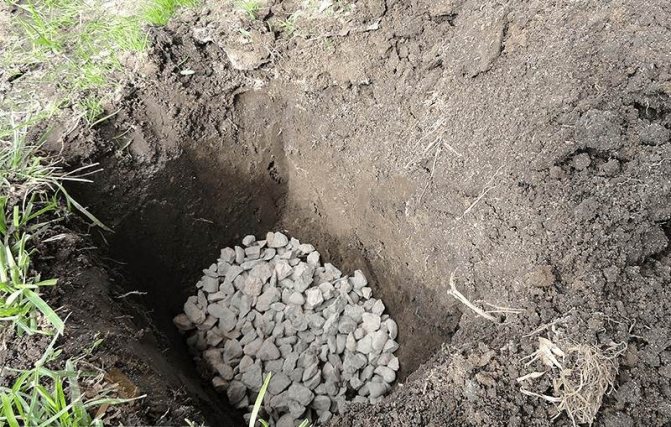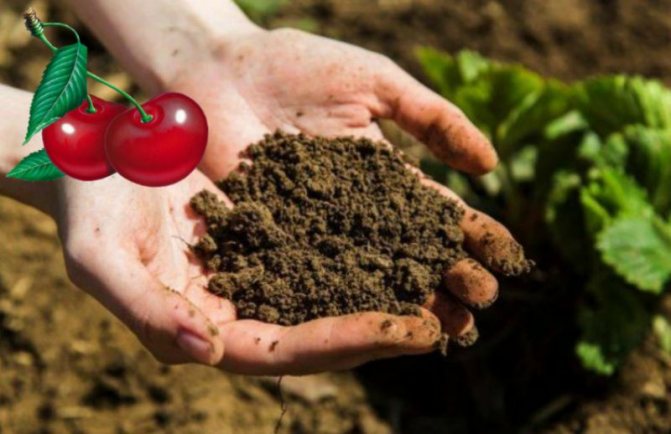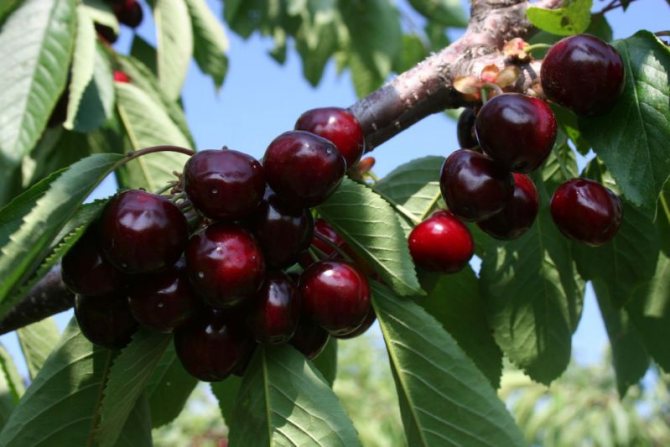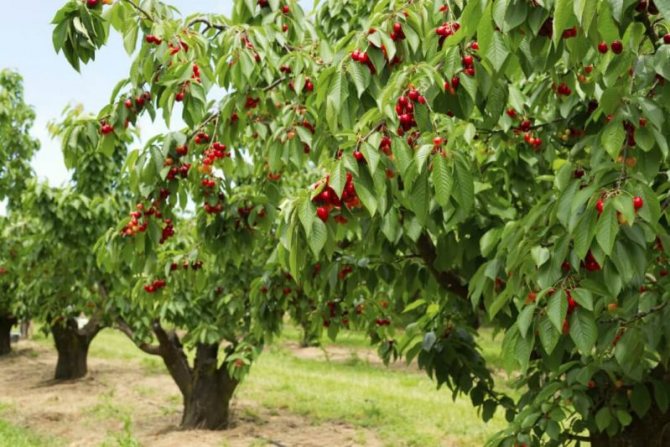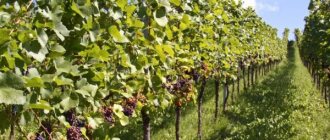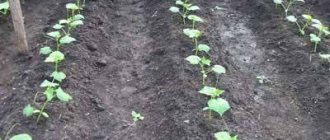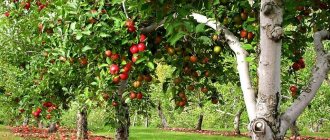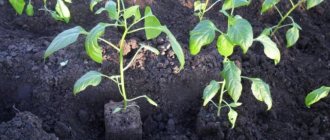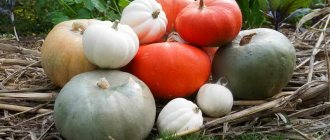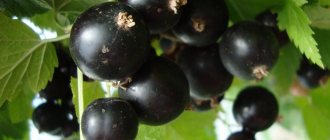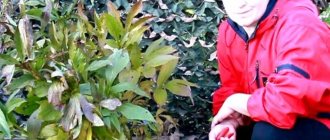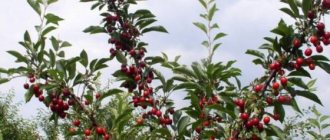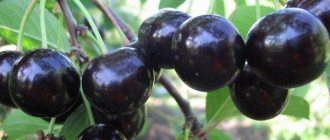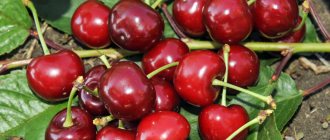Harvest beds Cherry
Every gardener and gardener strives to ensure that all trees look well-groomed, healthy and bear as much fruit as possible. But, if you have several of them, the question arises - at what distance you need to plant cherries. This is what we will try to figure out today, since there are several important details that should be paid attention to.
- 1 What determines the distance
- 2 Optimal seating arrangement
- 3 Video "At what distance to plant trees"
Basic concepts or what you need to know about cherries
I would like to say right away that cherry is an unpretentious tree and does not require additional care. It grows freely in almost any climatic environment, from sandy soil to fertile black soil. This tree is quite frost-resistant and quickly recovers after freezing (this feature is in demand in the northern regions of the country). Among other things, the tree does not require a lot of light, due to the fact that it is shade resistant.
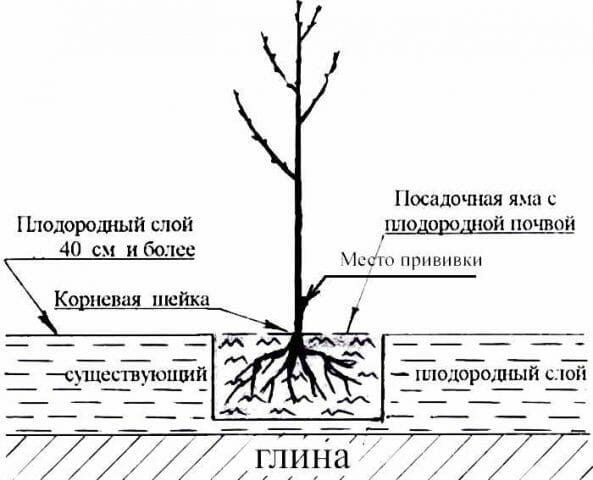
Cherry planting technology
What determines the distance
Planting directly depends on the cherry variety you have chosen to plant. It is recommended to place bush varieties at a distance of 2 or 2.5 meters from each other. This will provide them with optimal growth space. Cherry tree seedlings should be placed at large intervals of 3 to 4 meters. In addition, such varieties should be separated from other fruit trees, especially apple trees, and shrubs.
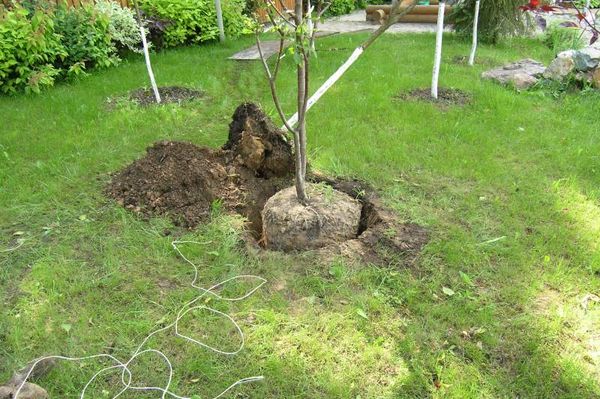

Ideally, you should choose a fairly large and free area. Also, there should be no buildings on the site, ideally, since they will interfere with air drainage, which is the outflow of air masses.
When planting seedlings, you need to evaluate the soil as well. What characteristics will the future garden have, how well the ground is lit. This is what will allow you to choose the right varieties of planting on the site. Feels good on flat surfaces, rooted well on the southern sides. Planting felted cherries is also recommended on the southwestern slopes. It must be remembered that cherry trees and seedlings do not do very well in peat bog lands. Planting is also recommended on neutral to moderately sandy soil.
Cherry planting and its features
The most successful landing site is the southern slopes. These conditions will contribute to the fact that excess melt water will go deep into the lower layers of the soil, and cold air will blow over the cherry. Now let's look at some important points that every gardening lover should know:
- Sandy loam soil is most suitable for planting, since it does not react to almost any precipitation and climate features;
- Groundwater must flow at a depth of at least 1.5 meters;
- All the main points of seasonal planting should be taken into account;
- Planting seedlings should be done in holes, with a diameter and depth of about 0.5 meters;
- Before planting, the roots of seedlings should be soaked in water for at least 4 hours, since during planting they lose a lot of moisture and may simply die.
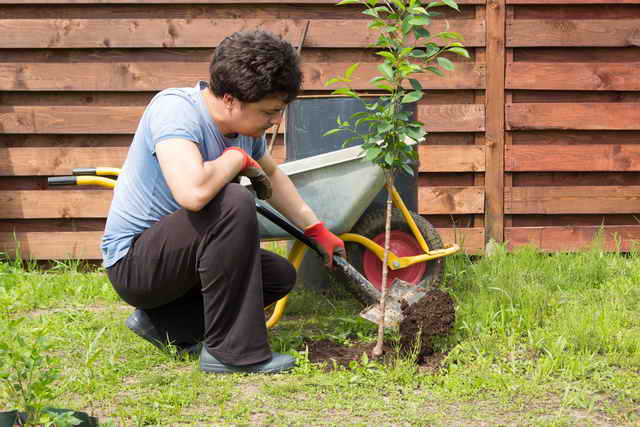

Planting young cherries. Illustration for this article is used under a standard license.
When to plant cherries in spring, in what month: timing
The optimal time for planting cherries in the spring in the garden is the period before the budding of the tree, in other words, before it enters the growing season (i.e. the plant must still sleep).
At the same time, an important condition for spring planting is a positive air temperature, and not only during the day (it should already be +5), but also at night.
Do not wait for the ground to completely thaw out; it is very good to plant seedlings with an open root system immediately after the snow melts, but the ground has not yet had time to warm up very much.
Thus, it is highly desirable to have time to plant while the seedlings are still "dormant", otherwise this will necessarily negatively affect their survival rate and disrupt their natural development cycle.
As for the approximate dates, depending on the climatic characteristics of the region, spring planting of cherries is recommended from late March-April to early May.
Advice! The best time for planting seedlings is cloudy and calm weather: early morning or late evening.
When is the best time to plant - in spring or autumn
Many gardeners believe that all fruit trees, including cherries, are still best planted. in the fallsince during this period, plants only grow roots, which means that the seedling will definitely not grow. Moreover, it is recommended to do this before the onset of stable frosts, that is, you should have about a month in stock (3-4 weeks).
Important! Too late to plant seedlings in the autumn is also not recommended, because the shoots must have time to mature well in order to successfully survive the winter.
However, if you are late, and frosts are expected within 1-2 weeks, then it is better to play it safe and postpone the planting of cherries until spring (you can save the seedling by digging it in the garden or planting it in a container and putting it in the basement).
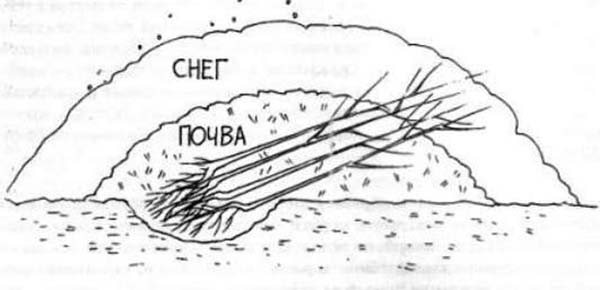

Thus, the approximate dates for planting cherries in autumn in different regions is the second half of September - the end of October.
By the way! On the contrary, some gardeners adhere to the old rule that pome crops - apples and pears - are best planted in autumn, and stone fruits - cherries, sweet cherries, plums, apricots - in spring.
The fact is that stone fruit crops are considered less winter-hardy, so it is recommended to plant them in the spring, so that they have time to take root and get stronger before winter.
However, if you are a resident of the South of Russia, then this is not a matter of principle. It's another matter if you are a representative of a region with a harsher climate (zones of risky farming).
Planting cherries in spring has other benefits:
- In the process of seedling growth, you will be able to quickly respond to possible problems (diseases, pests, lack of moisture) and immediately take the necessary measures to eliminate them.
- The spring supply of moisture in the soil allows the root system to adapt faster after planting and begin active growth.
- It is possible to prepare the site in advance, in the fall, so the soil will have time to sink by the spring, and this will help to avoid deepening the root collar.
Note! Cherry seedlings with a closed root system can be planted all year round - from April to October, unless it is too recommended to do this in the middle of summer, when it is very hot.
Video: in what time frame is it better to plant seedlings of fruit and berry crops
Planting dates in spring in different regions
Naturally, depending on climatic features, the timing of spring planting of cherries in different regions will vary:
- So, in the South of Russia, you can plant cherries in the second half of March or early April.
- But the gardeners of the Middle Strip (Moscow region) should wait until the 2nd decade of April.
- In Siberia and the Urals, cherry seedlings should be planted in open ground only in late April-early May.
According to the lunar calendar in 2020
It can help you choose the optimal date for planting seedlings moon calendar.
So, favorable days for spring planting of cherries in 2020, according to the lunar calendar, are:
- in March - 26-29;
- in April - 11-15, 24, 25;
- in May - 2-10.
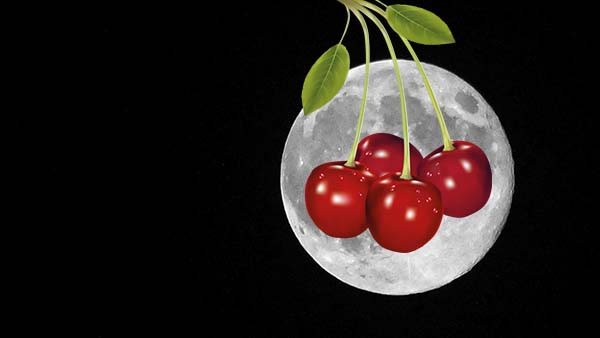

Of course, it is not always possible to get to the dacha on the appropriate days, so the main thing is not to plant cherries and any other crops on unfavorable dates according to the lunar calendar - the days of the New Moon and Full Moon, as well as the period when the Moon is in Aquarius, because it is a barren and dry sign - italicized.
Unfavorable days, according to the lunar calendar, for 2020 for planting cherry seedlings in spring, the following dates are:
- in March - 9, 19-21, 24;
- in April - 8, 15-17, 23;
- in May - 7, 13-14, 22;
- in June - 5, 9-11, 21.
According to the lunar calendar, from the magazine "1000 Tips for Summer Residents".
Optimal seating arrangement
At what distance to plant cherries from each other, we have already figured out. What is the best way to choose such a seating scheme that would be the most optimal and would allow you to get the greatest benefits and yield?


In order to properly plant not only cherries, but also cherries, first of all, the soil should be fertilized with humus and mineral fertilizers. Plums also require such fertilization before planting. In one hole under the tree, you can add no more than 20 kilograms of humus mixed with the ground. It is recommended to use ash, but use less than one kilogram per hole, especially if you need to plant cherries.
When planting in clay soil, it is customary to add 1 or 1.5 buckets of sand. A distance of about 3 meters must be observed when digging. Attention should also be paid to the fact that there should be enough free space between the seedlings for the growth of future shoots.
When choosing a scheme, also focus on the neighborhood of varieties of friends. When choosing cherry seedlings, you need to carefully pay attention to what other varieties it can exist in a summer cottage. Usually, dacha cherries are friends with other varieties of cherries, apple trees and plums.
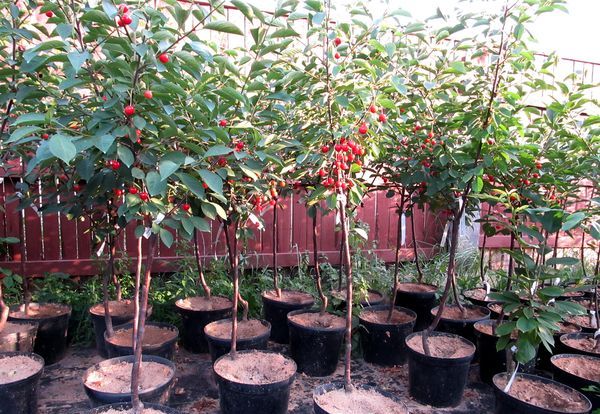

After planting, a small ridge is formed around it, which will protect against water loss. The planted cherry should be watered frequently and in sufficient quantity to keep the seedling growing. There must be a constant supply of fresh air. You should also pay attention to the fact that at least a meter should remain from the fence so that the shoots can grow unhindered.
Keeping a sufficient distance between trees will not only help you achieve good results and a large yield, but also create optimal conditions for growth. And your cherry orchard will always delight the eye.
Features of choosing a seedling
Getting a good garden tree with abundant fruiting and high palatability starts with choosing the right seedling. It is quite difficult to grow a cherry from a stone. Young trees should be purchased only in specialized nurseries, where they are not engaged in the resale of planting material, but in its cultivation.
In such nurseries, plants are planted on good soil, they are provided with proper care and preventive measures. Such a tree always has a tag indicating the variety and its characteristics, and in hybrids, the parental individuals must be indicated.
The acquisition of seedlings from hands, from random persons, leads to clogging of the garden plot with random, non-resistant and low-yielding varieties. After unsuccessful attempts to get a good harvest, such plantings have to be uprooted. There are some features that should be followed when choosing a seedling.
Purchased
In order to grow a strong and normally fruiting tree, one should first of all pay attention to the varieties that are zoned for the given region. Such cherries are suitable for the climatic characteristics of the landing site in terms of frost resistance, flowering and fruiting periods.A quality seedling is a tree 90-110 cm high, which has several branches and a branched root system. Its dimensions should reach 25-35 cm. The trunk and roots should not have mechanical damage, growths and spots of rot or mold. If you lightly scratch the top layer of the bark, then a bright green and moist layer is visible behind it. The roots should be light gray or white with no brown or brown spots. When the spine is bent, its elasticity is felt. It does not crack and, straightening, quickly takes on its original shape.
Self-grown
For reproduction of a good variety on your site, seedlings grown from root shoots are perfect. This is one of the most common ways to restore a cherry orchard after winter freezing. Varietal and selective plants are used to obtain root cuttings. In this case, the seedling will inherit all the positive qualities of the parent tree. The advantage of coppice seedlings is their high winter hardiness, and the disadvantage is a later entry into the fruiting period. The first fruits can appear only at 4 years old, and a good harvest can be expected 5 years after planting.
For reproduction, self-rooted varieties are selected that do not have too dense root growth.
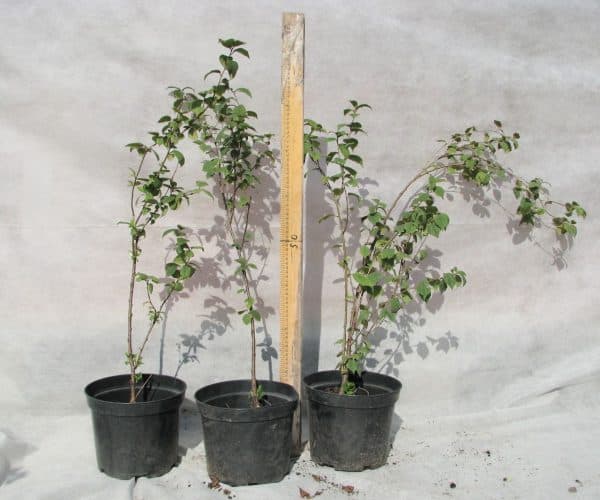

For growing a seedling, strong and strong shoots of one or two years of age are selected. Perennial offspring are not suitable for this purpose, since they have a poorly developed root system, and they receive all their nutrition from the mother plant.
Do not dig up root growth located closer than one meter from the parent tree. Such offspring do not have roots at all, but feed on the juices of the main plant.
If you dig up the root growth at a short distance from the trunk, there is always the possibility of damage to the parent's root system. The best root cuttings are those that grow in a well-lit area, and not in the shade of the parent tree. Harvesting of a root seedling can be done in the spring, before bud break or in early October. It is better to choose a cloudy day, without a bright sun, but also without rain. First, at a short distance from the selected plant, cut the root that goes to the parent tree. The plant is not dug up, but left in the ground until its own root system is formed. The aerial part of the stem is shortened by one third. Then the soil around the root layer should be fertilized with ammonium nitrate and watered. The next feeding is carried out at the end of June.
We understand the varieties
One of the most important things to do is choosing the right cherry variety.
It is necessary to start not only from your own preferences, but also from the climatic conditions in which you live. Also, in addition, you need to take into account the size of the plant, its whimsy, taste characteristics, as well as the frequency of fruiting.
You can find out about all this on your own by reading the necessary literature or contact the gardener from whom you will purchase seedlings or seeds.
What you need to know:
- For the central and northern stripes, only frost-resistant varieties of cherries are suitable. This includes the following types: Shokoladnitsa, Steady, Nizhnekamsk.
- For more temperate climatic regions, varieties with medium frost resistance are quite suitable. These include the following varieties of cherries: Vladimirskaya, Zhukovskaya, Bagryanaya.
- If you live in an area where the climate is rather humid and relatively warm, then you need to focus on fungus-resistant varieties of cherries. You should pay attention to the varieties Diamond, Toy, Crystal, Meeting.
- With a predominance of sandy soil, Mayak, Bolotovskaya, and Plamennaya take root best of all.
All cherry varieties are divided into 3 groups:
- early;
- medium;
- late.
It is best to purchase cherry seedlings from your nearest nursery. This will give some assurance that the tree will take root.
How to keep a seedling for spring
How to plant cherries in spring: a step-by-step guide
There are several ways to preserve the seedling for spring.
- To prevent the planting material from drying out for spring planting, it is necessary to dig a depression in the ground, up to 50 cm deep. The seedling is laid so that the crown of the tree looks to the south side. Dig in with soil and water. Sprinkle on top with sawdust 5 cm thick.
- For the northern regions, where there is frequent snow, you can dig the seedlings into the snow 10 cm. Sprinkle with sawdust on top. This will keep warm, the seedlings will not freeze at any temperature.
- You can also store seedlings in the apartment until spring. You need to purchase a special composition for the roots and polyethylene. The substrate is steamed and cooled. The seedling is dipped into a bag and the substrate is poured over the roots. The root system must be completely covered. Next, you need to add some water and tie a bag. Small holes are made in the bag. The seedlings are kept in the refrigerator.
For reference! Large seedlings can be stored in the garage or on the balcony.
Experienced gardening tips
Experienced gardeners advise, first of all, to adhere to planting dates. If you plant a tree in too cold weather or after the start of the growing season, the plant may die.
Remember that it is better to buy seedlings from specialized nurseries. The seller, at the request of the buyer, must provide a quality certificate. Thus, the gardener will protect the garden from diseases and pests.
A common mistake is applying a large amount of fertilizer. This will not help the tree to root faster; excessive feeding, on the contrary, disrupts the development of the plant. Also, cherries do not need feeding in the first year after planting - the tree has enough nutrition introduced into the planting pit.
Spring planting of cherry tree seedlings will not be difficult if you study all its subtleties in advance. Both experienced and novice gardeners, with the right preparation, can easily cope with planting and, as a result, will receive a rich harvest.
Useful properties of cherries
Cherries are rich in vitamin composition, macro- and microelements, organic acids, carbohydrates. In general, this berry is very healthy - a lot of vitamins A and C, E and PP, group B, phosphorus, potassium, iron, zinc and copper. The benefits are tryptophan and folic acid. And of course - antioxidants.
Thanks to such a diverse composition, cherries heal the cardiovascular system, helping to improve the condition of blood vessels and blood clotting, and increase hemoglobin levels. Improves brain function. Recommended as an antipyretic agent, relieves cough, improves appetite, mild laxative.
In folk medicine, cherries use not only berries, but also stalks, twigs, and bark, which have a diuretic and hemostatic effect. And the juice of the leaves heals wounds well. The broth in the old days was used for sore throat.
By the way, ellagic acid was found in cherries - a substance that inhibits the development of cancer cells.
Cherries are wonderful because they have wide processing possibilities. Today it is not only "turned" for compotes, digested for jam, jams and sauces, but also pickled, frozen, dried, dried, canned in its own juice. It goes as a filling in cakes, pies, dumplings, pies. A number of spirits are made on its basis.
Step by step guide
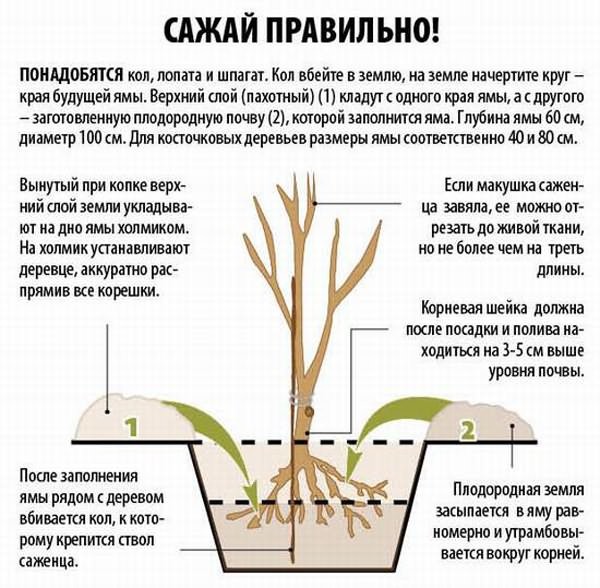

It is better to prepare a pit for planting in the fall. This is not categorical, if everything is done correctly, then cherries can be planted in freshly prepared pits. It is more convenient to make a pit in the form of a cube with sides of 60 cm - 60X60X60. If you make it deeper, the development of the root system of the planted tree will slow down, and if you make it less deep, the roots will be subject to all the vagaries of the weather: in summer - heat, in winter - frost.
The upper fertile layer is carefully removed to the side - it will be needed to prepare the soil mixture, and the earth from the bottom of the pit is laid out separately. The soil mixture is prepared from humus and fertile soil, mixed in a 1: 1 ratio. You can enhance its nutritional properties by adding wood ash to this mixture at the rate of 1.5 cups per bucket of mixture.
If you plan to plant not one, but several cherry seedlings, a separate pit is prepared for each of them. The distance between the pits is at least 3 m, and between the planted rows (if a future cherry orchard is planted) - 3.5 m.
A strong long peg is hammered into the center of the pit or slightly to the side of it into the bottom - it is needed to tie up the planted tree. Then a hill of fertile land is poured into the center of the pit. On top of this hill are placed cherry fathoms.
You need to add the earth a little, periodically trying on the seedling. Your task is to pour the earth on the bottom of the hole so that the root collar (the place where the roots go into the trunk of the tree) is 3-4 cm above ground level.
Having achieved this, we put the seedling on the top of the poured hill and carefully straighten the roots. For better survival, the roots can be dipped in a mash (a mixture of manure and clay diluted with water). Then we fill the hole to the top with earth. The prepared soil mixture is usually not enough, the top of the pit has to be filled up with earth removed from its bottom.
Compact the loosened earth by walking a little on it, but do not come close to the seedling. Tighten the edges of the formed near-stem circle more strongly, making a groove around its perimeter 8-10 cm deep.
At the end of planting, tie a cherry tree to a hammered peg, pour 3 buckets of water into the groove. When the soil absorbs moisture and settles a little, the tree trunk circle is mulched with sawdust or dry soil. At this stage, a 4-5 cm layer of mulch is enough.
Care after
Caring for cherries after planting is no less important than the process of planting a seedling itself. However, in this case there are also many features that you need to familiarize yourself with before trying on the role of a gardener.
These rules are as follows:
- The land around the tree must be completely weed-free;
- The soil should be loosened carefully at least once a month. You can loosen the near-trunk circle no deeper than 10 centimeters. Otherwise, the root system will suffer;
- The formation of a soil crust must not be allowed;
- Before wintering, the ground near the cherry itself and its rhizomes must be dug up.
Watering cherries should be done with extreme care. You cannot water the tree whenever you like. Frequent watering is also not suitable. In this case, an excessive amount of moisture has a bad effect on the condition of the roots, as well as the fruits - they simply begin to crack. During the season, the cherry is watered 4 times: after the flowering period, during the growth of the shoots, during the ripening of the berries and during the period before wintering.
Features of further care of the seedling
The first 2-3 days, the seedlings are advised to cover with agrofibre. So cherries adapt faster to a new place.
After planting, before rooting, the seedling is watered once every 3 days. If the weather is rainy, watering can be reduced - excess moisture is detrimental to the culture. It is necessary to pour up to 20 liters of water under one trunk.
In order for moisture to better saturate the roots, the trunk circle is mulched. Natural materials are suitable as mulch - hay, straw, sawdust, fallen leaves. The optimum thickness of the mulch layer is 10 cm. After planting, you can immediately prune.
Check out the tips for pruning cherries at home for beginners.
An annual tree is shortened to 0.8 m. In a two-year-old seedling, the shoots are shortened by 1/3. The central trunk is cut so that the upper branch is 15 cm below its top.
